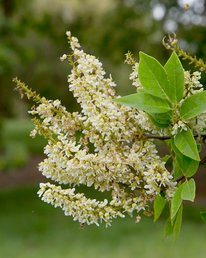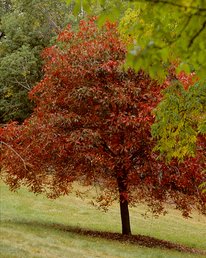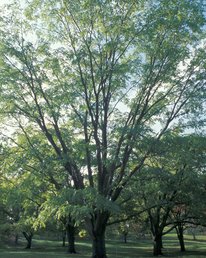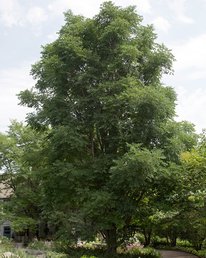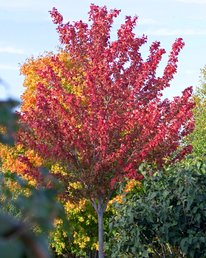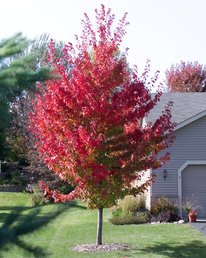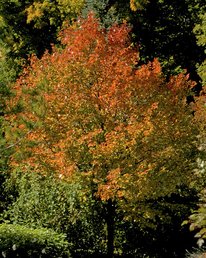Stately shade trees add a sense of permanence and tenacity to the landscape, and can provide a ceiling for other plantings. U of M varieties have been selected and tested though many seasons to assure healthy trees with attractive features.
Amur Maackia (Maackia amurensis)
The little-known Summertime™ amur maackia is a small, tough tree that glows with silvery spring foliage and unusual creamy white flowers in July and August.
University of Minnesota Amur Maackia Variety
Summertime™
- Small cream colored flowers bloom in late-July to early-August
- Silvery leaves in spring turn to deep green until leaf fall
- Mottled bark provides winter interest
- 18' wide by 18' tall
- Released in 2001
Buckeye
The 'Autumn Splendor' buckeye is popular for its stunning maroon fall color, and its tolerance of de-icing salts makes it a good boulevard tree. It has showy flowers in late spring and shinny nut-like buckeyes in fall.
University of Minnesota Buckeye Variety
Autumn Splendor
- Clusters of yellow flowers
- Flowers are followed by shiny, nut-like fruits and brilliant maroon fall color
- Resists leaf scorch diseases
- 30' wide by 35' tall
- Released in 1980
Corktree
Corktrees got their name from the deeply furrowed and soft corky bark. The fast-growing 'His Majesty' develops an open, spreading crown with coarse branches and dark green foliage. This male selection produces no seeds or fruit and is therefore not spread by birds.
University of Minnesota Corktree Variety
His Majesty
- Fast-growing, open-spreading, male selection producing no fruit
- Interesting corky bark
- Tolerates alkaline soils
- Resistant to insects and diseases
- 40' wide by 35' tall
- Released in 1996
Hornbeam
Skylark™ Hornbeam was part of former U of M breeder Harold Pellett’s effort to breed a more cold-hardy fastigiate hornbeam. A cross between Carpinus × ‘Shelby’, Skylark™ has undergone extensive trials at the the Morton Arboretum where they have a successful, long-term hornbeam breeding and selection program. Pest free, its remarkable adaptive character is enhanced by hybrid vigor and strong mycorrhizal roots that allow it to thrive even in droughty conditions.
University of Minnesota Hornbeam Variety
Skylark™
- Combines the hardiness of Carpinus caroliniana with the upright habit of Carpinus betulus ‘Fastigiata’
- Relatively narrow upright form, compact habit, and deep green serrated foliage
- With age, its bark becomes more attractive with a fluted character
- 10-15' wide and 25-35' tall
- Hardy in zones 5-8
- Released in 2018
- Skylark™ was released jointly with the Morton Arboretum.
Kentucky Coffeetree
The ‘Stately Manor’ Kentucky coffeetree is a male selection, with no pods, that offers interesting gray bark and yellow fall color. A good shade tree with a narrow, upright form and large leaves, it could be a suitable replacement for ash in Minnesota.
True North™, which was first discovered in 1972, is a male specimen notable for its narrow, upright-oval form and superior branch architecture. Like all coffeetrees, this selection is relatively tolerant of cold, heat, and drought and is adaptable to a range of soil conditions.
University of Minnesota Kentucky Coffeetree Varieties
Stately Manor
- Male specimen; no seed pods
- Tolerates a wide variety of soil conditions
- Unusual, deeply furrowed bark adds winter interest
- 40' wide by 50' tall
- Released in 2002
True North™
- Male specimen; no seed pods
- Notable for its narrow, upright-oval form, superior branch architecture, and lack of fruit and seeds
- Features large, dark-green compound leaves in summer and a somewhat coarse texture with scaly bark during the winter months
- 20-30' wide by 50-70' tall
- Released in 2015
Poplar
The InnovaTree™ poplar variety is a fast-growing tree selectively bred by UMN researchers. It is ideal for fast landscaping and quick shade and privacy screens for residential applications. Conservation practice uses include wildlife plantings, windbreaks, and erosion control. Commercial uses include carbon capture, phytoremediation, and biomass feedstock.
University of Minnesota Poplar Variety
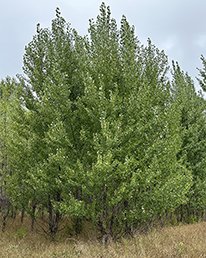
InnovaTree™
This poplar variety is a large upright-oval shade tree ideal for larger yards and parks. This versatile tree quickly produces shade and privacy. Its heart-shaped leaves turn golden yellow in fall.
- Grows up to 10 feet/year
- Full height is 75 feet
- Grows well across climate zones; Hardy in Zones 3-6
- Disease resistant
- Cottonless and will not develop root sprouts
- Released in 2023
To learn more about InnovaTree, visit innovatree.umn.edu
Red Maple
Brilliant early fall color distinguishes the Firefall™ Freeman maple. It is the result of a cross between ‘Beebe,’ a cut-leaf silver maple, and an earlier University red maple introduction, ‘Autumn Spire.’ This male selection produces no messy seed. Field trials began in 1992, with young trees evaluated for form, cold tolerance, and quality and timing of autumn leaf color. The initial selections were propagated by softwood cuttings in 1994 and sent to cooperators in Iowa, Oregon, Manitoba, and outstate Minnesota before introduction in 2005.
University of Minnesota Red Maple Varieties
Autumn Spire
- Upright form and good red fall color
- 40' tall
- Released in 1992
Firefall™ Freeman
- Early fall color, orange to scarlet
- 50' tall
- Released in 2005
Northwood
- Bright orange fall color
- 50' tall
- 1980
Summertime™, True North™ and Firefall™ are trademarks of the University of Minnesota.

